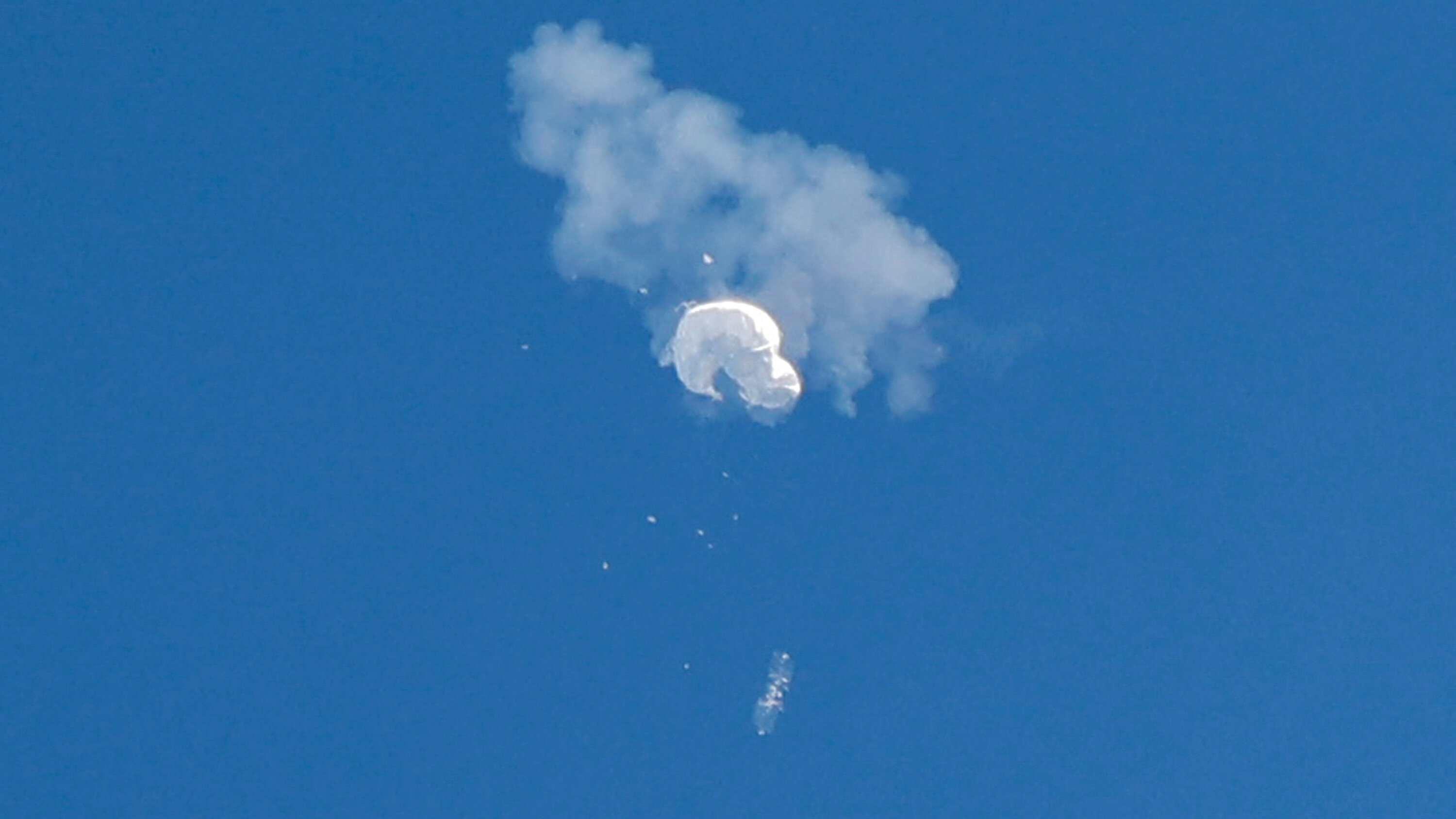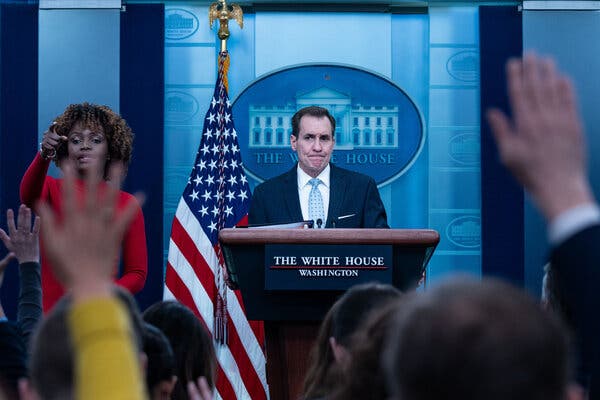U.S.-China Tensions Rise Over Spy Programs Amid UFO Investigations
The Biden administration is looking into mysterious U.F.O. encounters and pushing back against China over accusations of widespread espionage.

WASHINGTON — Tensions between the United States and China escalated on Monday as the two nations traded fiery accusations over spying programs, in the aftermath of the U.S. downing of a Chinese spy balloon and three unidentified flying objects a week later over North America.
In a sign of how closely the United States had been monitoring the balloon surveillance program directed by the Chinese military recently, U.S. officials said in interviews that they began tracking the spy balloon as it lifted off from Hainan Island in southern China in late January.
As it drifted over the Aleutian Islands near Alaska and traversed Canada and then Montana, officials said, military leaders alerted President Biden that it was almost certainly the same kind of aerial craft that the U.S. had detected twice by Hawaii, and that it had spotted over Texas and Florida. The balloon was shot down off the coast of South Carolina by a U.S. fighter jet on Feb. 4, and military officials said on Monday that crews had recovered “significant debris” from the craft that included “priority sensor and electronics pieces.”
The diplomatic crisis over it has been intensifying. A Chinese foreign ministry spokesman, Wang Wenbin, said Monday in Beijing that the United States ran the “largest spy network in the world,” and that it had conducted extensive global surveillance, including capturing electronic communications, that had compromised “the privacy of citizens across the world.”
Mr. Wang also said the United States had sent 10 balloons illegally into Chinese airspace since last year, an accusation that prompted an immediate and furious denial from the White House.
Adrienne Watson, a spokeswoman for the National Security Council, issued a statement saying “any claim that the U.S. government operates surveillance balloons over the P.R.C. is false,” referring to the People’s Republic of China.
Ms. Watson pointed to China’s spy balloon program and said that Beijing “to this day has failed to offer any credible explanations for its intrusion into our airspace and the airspace of others.”
The combative exchange indicates how quickly the espionage programs of the two nations are becoming a revived point of tension in a relationship that is caught in a downward spiral. Mr. Biden and President Xi Jinping of China have sought since a meeting in Bali, Indonesia, in November to stabilize the ties, but the furor set off by the spy balloon has blown up those efforts.
The United States does run extensive espionage programs aimed at China. The collision of a U.S. electronic spy plane and a Chinese fighter jet in 2001, which led to the presumed death of a Chinese pilot, revealed the scope of the American effort to collect electronic communications, though that plane was well off China’s coast. The National Security Agency has pierced the networks of China’s leading telecommunications company, Huawei, and tracked Chinese soldiers as they moved nuclear weapons.
China has long done the same to the United States, stealing the designs for the F-35 stealth fighter and security clearance files of 22 million Americans from the databases of the Office of Personnel Management.
Yet the message from Washington of the past week is that direct physical intrusions of American and allied airspace are different, and John F. Kirby, a spokesman for the National Security Council, said on Monday that he was unaware of any similar U.S. program in Chinese airspace.
If any of the three flying objects destroyed in North America from Friday to Sunday turn out to be Chinese, it would amount to a major provocation on the heels of the spy balloon episode. Several U.S. officials stressed they were not jumping to the conclusion that the objects were Chinese surveillance machines.
Mr. Biden has ordered top national security officials to review how the United States monitors its airspace and whether it needs to change procedures, Mr. Kirby said Monday.
Since the spy balloon episode, the U.S. military has adjusted its radar filters so devices now pick up more objects, he said, and that could account for the spate of sightings that led to the three shootdowns. Several officials said sensor systems are now picking up many signals that are normally automatically filtered out, including migrating flocks of birds and hang gliders.
White House officials were clearly struggling to strike the right balance between showing that they are on heightened alert and not setting off alarms over normal events. And one official said that it was now clear that pilots for NORAD, the North American Aerospace Defense Command, would need revised guidance about when to shoot down objects. Until this weekend, they had rarely fired on any.
“I think we just don’t know right now in terms of whether there needs to be threshold changes,” Mr. Kirby said.
U.S. agencies are still investigating the origins of the three mysterious objects that U.S. fighter jets shot down between Friday and Sunday on the orders of Mr. Biden and Prime Minister Justin Trudeau of Canada. Debris recovery efforts are underway at the sites in Alaska, the Yukon Territory in Canada and the Canadian side of Lake Huron, Mr. Kirby said.
What we consider before using anonymous sources. Do the sources know the information? What’s their motivation for telling us? Have they proved reliable in the past? Can we corroborate the information? Even with these questions satisfied, The Times uses anonymous sources as a last resort. The reporter and at least one editor know the identity of the source.
The three objects did not pose a danger to people on the ground, were not sending out communications signals, did not have people inside and did not have maneuvering or propulsion capabilities, he said. They flew at altitudes of between 20,000 feet and 40,000 feet, much lower than the Chinese spy balloon, and they posed a potential risk to civilian air traffic, Mr. Kirby added.
The objects appeared to be pushed by winds, which carried them from west to east, he said.
The object shot down over Lake Huron after it had entered Michigan had an octagonal structure with strings hanging off but had no visible payload, U.S. officials said. They have been careful not to call any of the recent three objects “balloons.”
The Biden administration said last week that China had sent surveillance balloons over more than 40 nations on five continents, violating their sovereignty.
A suspected high-altitude Chinese surveillance balloon flew near sensitive U.S. military installations in the Middle East last fall, but it remained far enough offshore that American officials did not deem it a threat and only monitored it as it transited the region, a senior U.S. official, speaking on the condition of anonymity to discuss operational details, said on Monday.
The balloon originated in or near China and traveled westward toward the Middle East — the opposite direction of prevailing winds and the route taken by the spy balloon that was shot down over the Atlantic Ocean — suggesting that the machine had its own source of propulsion, the official said.
Military officials in Asia tracked the balloon until it moved west into Middle Eastern air space, where they handed off monitoring duties to military colleagues there, the official said.
The top U.S. Air Force commander in the Middle East, Lt. Gen. Alexus Grynkewich, appeared to reference the incident in a meeting with reporters on Monday, citing an encounter in his region last fall involving a high-altitude balloon. He declined to provide details, citing the sensitive nature of the incident.
“It never got to the point where it was a high enough concern,” the general said. “We just monitored it.”
China has said the balloon shot down by the United States and one spotted over Latin America last week — which the Pentagon said was also for spying — were civilian machines used for weather research or test flight purposes.
Mr. Wang, the foreign ministry spokesman, said Monday that it was “common” for American balloons to enter the airspace of other nations illegally, and that U.S. high-altitude balloons had “illegally flown over China’s airspace” more than 10 times since last year.
China has a broad definition of its borders — it makes expansive claims over disputed territories, including around Taiwan, the South China Sea, the East China Sea and the Himalayas — and it was unclear exactly to what airspace Mr. Wang was referring.
The bulk of America’s most important intelligence comes from its network of sophisticated spy satellites, a robust effort to intercept communications electronically, as well as information from human sources. While the C.I.A.’s Chinese spy network was decimated more than a decade ago by Chinese counterintelligence, the United States has been trying to rebuild it.
The United States generally avoids sending reconnaissance devices into the sovereign air space of another country, especially countries like China with sophisticated air defense capabilities. Sending craft that can be easily intercepted risks giving away important capabilities.
Aerial collection is a relatively small part of U.S. intelligence gathering, and for the most part U.S. reconnaissance planes fly in international airspace, just outside the territorial waters of other countries.
While the U.S. has considered developing high-altitude surveillance craft for some counterterrorism or counternarcotics missions, officials have said those methods would do little good in spying on Russia or China because those countries would quickly detect and destroy them, according to former officials.
The United States and China have had many explosive disputes over espionage.
In 2014, a Chinese fighter jet flew within 30 feet of a U.S. Navy surveillance plane in international airspace just off the Chinese coast. The encounter was “very, very close, very dangerous,” Mr. Kirby, who was the Pentagon spokesman at the time, had told reporters.
Col. Yang Yujun, a spokesman for the Chinese Ministry of National Defense, said then that “it is large-scale, high-frequency close-proximity surveillance by the United States that endangers Chinese-U.S. maritime and aviation safety.”

By contrast, when China shot down a U.S. spy balloon inside its borders in 1974, both nations handled the episode quietly. China and the United States were rebuilding diplomatic relations after a 23-year break, and the Chinese government kept the incident hidden by labeling it a military secret, according to an article in a magazine managed by the party school of the central committee of the Chinese Communist Party.
With friction growing, Secretary of State Antony J. Blinken has not said when he will reschedule a trip to Beijing that he canceled during the spy balloon uproar. He and Wang Yi, China’s top foreign policy official, are both expected to attend the annual Munich Security Conference in Germany, which begins Friday. But Ned Price, a State Department spokesman, said Monday that “there’s no meeting on the books.”
Helene Cooper and Michael Crowley contributed reporting from Washington, and Li You contributed research from Shanghai.
This article has been archived for your research. The original version from The New York Times can be found here.


